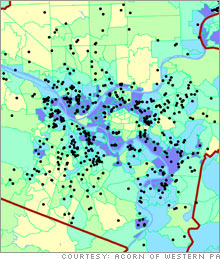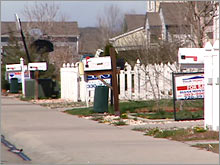The ugly face of foreclosureWhen foreclosures climb, entire communities can go down.NEW YORK (CNNMoney.com) -- Foreclosures are devastating communities across the United States, and the impact may only worsen as more subprime adjustable mortgages reset during the next few months. Foreclosure filings are up 35 percent nationwide since a year ago, according to RealtyTrac.
Even in prosperous Sunbelt places like Pima County, Ariz., which includes Tucson, foreclosures climbed 51 percent in just two years. Maryellen Hayden, executive director of the Pittsburgh office of the Association of Community Organizations for Reform Now (ACORN), reports that foreclosures have skyrocketed in Allegheny County from 1,287 in 1996 to 4,944 in 2006. In Slavic Village, a working-class Cleveland neighborhood of about 11,000 homes, 600 of them are vacant and boarded up, according to City Councilman Tony Branchatelli. "Foreclosures have helped destabilize not only Cleveland neighborhoods but inner ring suburbs like Shaker Heights and Euclid as well," said Jim Rokakis, treasurer of Cuyahoga County, which includes Cleveland, one of the hardest-hit U.S. cities. And the worst may be yet to come. Rokakis said Cuyahoga County is on track for 16,000 foreclosures this year, up from about 3,500 annually in Cleveland during the mid-1990s. The impact can reach far beyond the affected homeowners. Rokakis says streets lined with foreclosures look like "mouths with teeth knocked out of them." In places like Slavic Village, according to Branchatelli, you can't go down a single street without seeing at least one vacant house. On some Pittsburgh streets, reports Hayden, every fifth or sixth house is boarded up. Dan Immergluck, associate professor of city and regional planning at Georgia Tech, said that for every foreclosure within an eighth of a mile of a house - two and a half city blocks in every direction - the home's value drops by about 1 percent. The vacancies look bad enough, but it's what happens next that really hurts. "The bad people in a community find out right away when a house has been foreclosed on," said Hayden. "They come in and steal the copper plumbing. I've even seen them strip the aluminum siding off to sell. The houses become havens for drug dealers." Fighting those problems off, stabilizing the community and redeveloping blighted areas are a challenge for cash-starved municipalities. And they have less money to pay for it because foreclosures cause tax collections to suffer. Not only do foreclosures, abandonment and demolition take properties off the tax rolls; the remaining homeowners often want their assessments lowered and taxes cut to reflect their plummeting property values. "More than 64,000 people in Cuyahoga County alone filed an objection to their assessments this year because their property values have dropped," Rokakis said. And the actual owners of the foreclosed properties - the investors who own the loans - may stop paying taxes as well. Said Branchatelli, "They may send someone around to take a look at the place, who decides it's not worth even going through the foreclosure process. They may just take a powder." Because of unfiled paperwork in many of those cases, houses may stay in limbo for months, deteriorating further until they're completely unsalvageable. Rokakis himself recently experienced, secondhand, the pain of foreclosure by attending the sheriff's auction of his boyhood home. The outstanding balance on the mortgage was $85,000 but the house sold at auction for just $19,000. As he walked through the living room before the sale and thought about how his parents raised seven kids there, he overheard buyers talking about what they would do to the property: rent it, flip it, raze it. "It was a bummer," said Rokakis. Contemplating the next few months of increasing foreclosure activity leaves him no happier. "Our subprime delinquency rate is 25 percent right now," he said, "and rising. The day may soon come when it's 50 percent." |
|


